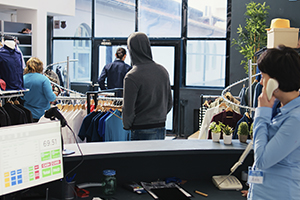C.G.S. § 53-142k — Organized Retail Theft

Connecticut treats “crew” shoplifting as its own felony. If someone, for financial gain and together with one or more people, commits larceny by shoplifting (e.g., runs goods past the point of sale, uses boosters, swaps tags, or coordinates grab-and-go runs), prosecutors can charge Organized Retail Theft under § 53-142k. This statute is aimed at coordinated retail theft rings, not one-off shoplifting.
What the State Must Prove (Elements in Plain English)To convict under § 53-142k, the State generally needs to show that you:
- Acted for financial gain; and
- In conjunction with at least one other person (planning, directing, assisting, or acting together); and
- Committed Larceny by shoplifting (any of the usual retail-theft methods).
Organized Retail Theft is charged as a Class D felony (exposure up to 5 years in prison, up to a $5,000 fine, and probation). Accessory liability tied to this offense is treated the same way – conspiracy and attempt.
How These Cases Are BuiltProsecutors typically stack evidence such as:
- Coordinated store entries/exits, “runner/driver” patterns, shared shopping lists, or group chats.
- Receipts, POS logs, and surveillance tying people to specific transactions/merchandise.
- Seized tools (e.g., embossers/encoders), piles of new goods or gift cards, or identical SKUs across stores.
- Travel patterns (multiple stores in a short window) and divided roles (lookout, runner, driver).
- Two or more people hitting electronics or designer stores in quick succession, loading a getaway car.
- One person swipes while another relays which SKUs to grab and where to meet.
- Gift-card “washing” or bulk returns orchestrated by a group.
- Unlawful stop/search: Many arrests start with thin car stops or consent issues—suppression can collapse the case.
- No “in conjunction with” proof: Mere presence in a car or store does not equal coordinated theft.
- No financial-gain intent: Being nearby new merchandise isn’t the same as joining a profit-motivated crew.
- No link to specific swipes: If video/receipts don’t clearly ID you, the larceny tie-in is weak.
- Tool ≠ use/knowledge: Finding an encoder in a trunk doesn’t prove you used or even knew about it.
For qualifying first-time clients with limited records, AR can be a path to dismissal and erasure. It isn’t automatic—judges scrutinize crew-theft cases. What helps: fast restitution/returns where possible, verified employment/school, clean compliance while the case is pending, and a tight mitigation plan showing this won’t repeat.
What to Do Now (First 48 Hours)- Stop talking to loss-prevention or detectives; let counsel handle communications.
- Preserve evidence: receipts, texts, rideshare history, videos, and your timeline of movements.
- Give me the paperwork: complaint, property sheets, bond terms, any search-warrant inventory.
- Travel/work planning: if you live out of state, we’ll seek video pretrials and reasonable travel permissions.
- Conspiracy (§ 53a-48)
- Larceny (by degree) (§§ 53a-122 to 53a-125b)
- Illegal use of a payment card (§ 53a-128d)
- Receiving goods obtained by illegal use of a payment card (§ 53a-128e)
- Identity theft (degrees) (§§ 53a-129a–129d)
- Accessory to organized retail theft (commonly referenced alongside § 53-142k)
Yes. Shoplifting usually lands under the larceny statutes. § 53-142k is a separate felony aimed at coordinated, for-profit crew activity.
Do Prosecutors Have to Prove I Personally Stole Items?Not necessarily. Acting “in conjunction with” others for financial gain can be enough if the State ties you to the plan or shared actions.
What if I Was Just the Driver?Drivers often get charged via conspiracy/accessory theories. We attack knowledge and intent and the link to any specific theft.
Will Paying Restitution Help?It often helps negotiations and AR eligibility, but it’s not a get-out-of-court card. We combine restitution with legal defenses.
Can I Get AR on an Organized-Retail-Theft Charge?Sometimes, if you’re eligible and the judge agrees. We build a disciplined AR package to maximize your odds.
Do Out-Of-State Clients Have to Appear Every Time?Not always. We frequently arrange video pretrials and limited in-person dates when the court permits.
What Happens to My Record if the Case Is Dismissed With AR?On successful completion, the charge is dismissed and erased under Connecticut law.
Talk to a LawyerFor more on arraignment, bond, and the case process, see our Criminal Defense page, or call (203) 357-5555 or use our contact page for a free confidential strategy session today with Attorney Allan F. Friedman Criminal Lawyer.
 Allan F. Friedman Criminal Lawyer Home
Allan F. Friedman Criminal Lawyer Home















